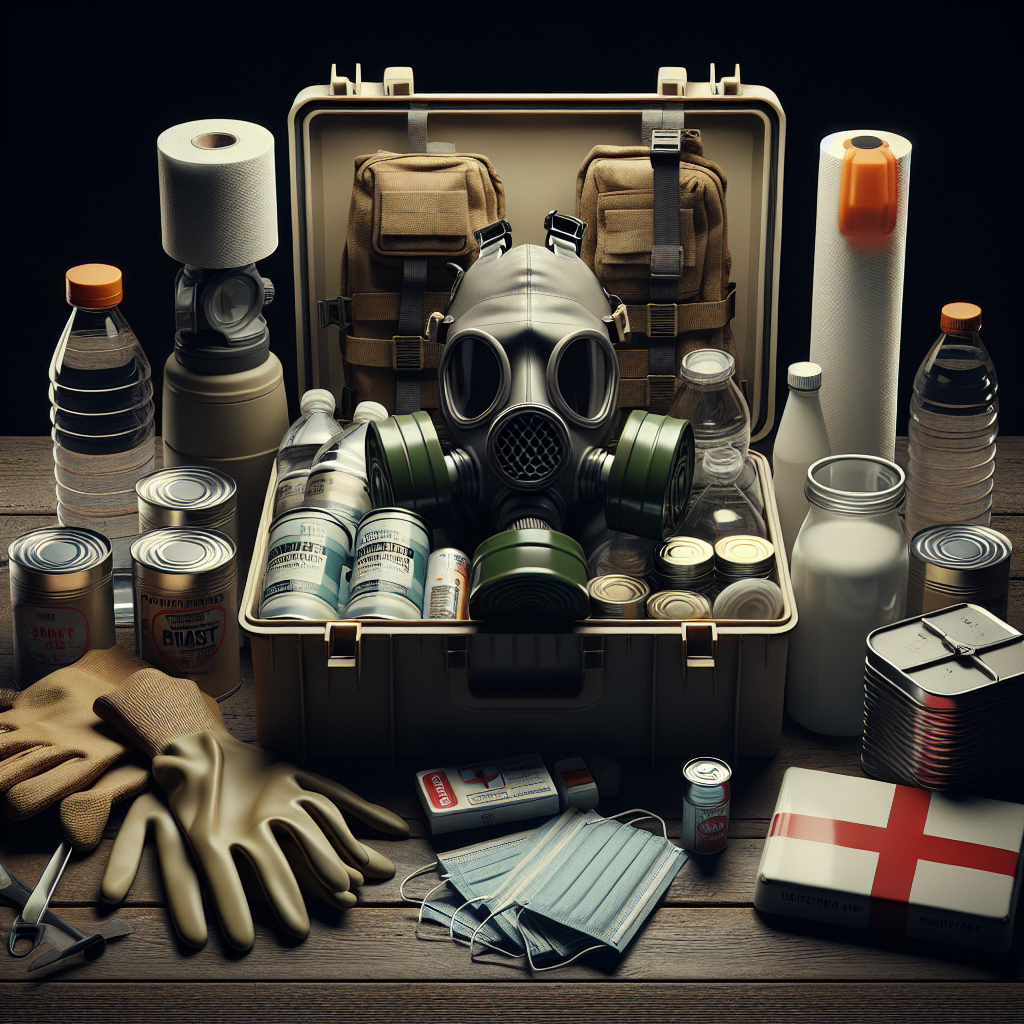
In today’s unpredictable world, it is crucial to be prepared for any unforeseen circumstances, including the possibility of a biological or chemical attack. Understanding the necessary steps to take in such a situation can mean the difference between panic and composure. This article aims to provide you with essential information on how to effectively prepare for a biological or chemical attack, ensuring your safety and peace of mind. Stay informed and equipped to face the unforeseen challenges that may arise in this ever-changing world.
Understanding Biological and Chemical Attacks
What are biological and chemical attacks?
Biological and chemical attacks refer to deliberate acts aimed at using biological or chemical substances as weapons to harm or kill people, animals, or plants. These attacks involve the release of harmful agents such as toxins, bacteria, viruses, or chemicals in a concentrated form or dispersing them in the air, water, or food supply. The intent is to cause widespread panic, harm, and disruption.
Why are people concerned about these attacks?
People are concerned about biological and chemical attacks due to their potential for causing significant harm and even mass casualties. These attacks can be stealthy, difficult to detect, and have long-lasting effects on both individuals and communities. The fear of these attacks arises from the devastating consequences they can have on human health, the environment, and social infrastructure.
What are the potential impacts of these attacks?
The potential impacts of biological and chemical attacks are far-reaching. They can lead to severe injuries, illnesses, and even death. Depending on the nature of the attack, they can also cause widespread panic, disruption of essential services, and economic consequences. Additionally, these attacks can strain healthcare systems and emergency response resources, making it difficult to provide timely assistance to affected individuals. The psychological impact on survivors and society as a whole can be long-lasting and profound.
Creating an Emergency Plan
Preparing for biological and chemical attacks requires careful planning and preparedness. By developing an emergency plan, you can ensure that you and your loved ones have a clear course of action in the event of an attack.
Know the risk in your area
The first step in creating an emergency plan is to understand the specific risks associated with your geographical location. Research the potential biological and chemical threats in your area, such as nearby facilities handling hazardous materials or the presence of disease outbreaks. This knowledge will help you tailor your plan to address the most likely scenarios.
Develop a communication plan
Effective communication is crucial during emergencies. Establish a communication plan with your family, friends, and neighbors, outlining how you will communicate and where to meet in case of an attack. Designate a family member or friend from outside the area as a central point of contact, as local communication networks may be disrupted.
Designate a meeting place
Choose a designated meeting place where your family can gather in the event of an attack or evacuation. This location should be easily accessible and away from potential danger zones. Make sure everyone in your household knows the address and how to navigate to the meeting place.
Prepare a bug-out bag
Assemble a bug-out bag or emergency kit with essential supplies to sustain you and your family for at least 72 hours. Include items such as non-perishable food, drinking water, medication, a first aid kit, flashlights, batteries, extra clothing, and important documents. Keep the bag easily accessible in case you need to evacuate quickly.
Protective Measures
Apart from having a well-thought-out emergency plan, taking protective measures is essential to reduce the risks associated with biological and chemical attacks.
Stay informed
Stay informed about potential threats by regularly monitoring official sources of information like local emergency management agencies, the Centers for Disease Control and Prevention (CDC), and law enforcement agencies. Sign up for alerts and notifications to receive real-time updates on any potential threats in your area.
Stock up on emergency supplies
Build up a stockpile of emergency supplies that can sustain you and your family for an extended period. Stock up on items such as bottled water, non-perishable food, medication, hygiene products, and disinfectants. Rotate these supplies periodically to ensure they remain fresh and usable.
Create a safe room
Designate a safe room in your home where you and your family can seek shelter during an attack. Choose a room with no windows or external vents, such as a basement or an interior room on the lowest floor. Seal the room as best as possible and keep it stocked with emergency supplies, including a battery-powered radio and a portable air purifier if available.
Learn basic first aid
Equipping yourself with basic first aid knowledge and skills can be invaluable in an emergency situation. Enroll in a first aid training course to learn how to treat common injuries and medical conditions. Be familiar with techniques such as CPR, wound care, and handling potential exposure to harmful substances.
Stay vigilant
Remain vigilant and report any suspicious activities or packages to the appropriate authorities. Be cautious of unusual odors or symptoms in yourself and others. Pay attention to news reports and follow the guidance provided by health and emergency management agencies.
Prevention and Preparedness Tips for Biological Attacks
To enhance your preparedness for biological attacks specifically, consider implementing the following prevention and preparedness tips:
Understand different types of biological agents
Educate yourself about the different types of biological agents that could be used in an attack. Learn about their routes of transmission, symptoms, and recommended treatments. The CDC and other reputable sources provide valuable information on various biological agents, their characteristics, and potential impacts.
Stay updated with vaccinations
Stay current with your vaccinations, as they can protect you from certain diseases that might be used as biological weapons. Ensure that you and your family members receive recommended immunizations and keep records of your vaccinations in a readily accessible location.
Practice proper hygiene
Practicing good hygiene can significantly reduce the risk of contracting or spreading diseases. Wash your hands frequently with soap and water for at least 20 seconds. Use hand sanitizers when soap and water are not available. Cover your mouth and nose with a tissue or your elbow when coughing or sneezing, and dispose of used tissues properly. Avoid touching your face, especially your eyes, nose, and mouth.
Create a clean environment
Maintain a clean and sanitary living environment to minimize the risk of disease transmission. Regularly clean and disinfect commonly touched surfaces such as doorknobs, light switches, countertops, and electronics. Use appropriate disinfectants that are effective against the targeted pathogens.
Prepare for decontamination
Establish a decontamination plan in case you or your surroundings become exposed to biological agents. Familiarize yourself with decontamination procedures recommended by health authorities. This may involve removing contaminated clothing, washing thoroughly with soap and water, and seeking medical attention if necessary.
Prevention and Preparedness Tips for Chemical Attacks
For preparedness against chemical attacks, consider the following prevention and preparedness tips:
Learn about different chemical agents
Educate yourself about different chemical agents that could be used in an attack and their potential effects. Understand their characteristics, symptoms, and appropriate actions to take in response. The Department of Homeland Security (DHS) and other reputable sources provide information on chemical agents and their implications.
Develop a sheltering plan
In the event of a chemical attack, having a sheltering plan is crucial. Identify a safe and secure location in your home or community where you can seek shelter. This area should be above ground level, away from windows and external vents, and preferably have a supply of emergency provisions. Seal the room as much as possible to prevent the entry of chemical agents.
Get a gas mask or respirator
Consider acquiring a gas mask or respirator certified for protection against chemical agents. Follow proper fitting and usage instructions to ensure their effectiveness. Train yourself and family members on how to put on and use these devices correctly.
Learn proper decontamination techniques
Familiarize yourself with proper decontamination procedures for chemical exposures. This may involve removing contaminated clothing immediately, showering thoroughly with soap and water, and seeking medical attention. Follow the guidance provided by emergency management agencies and medical professionals.
Seeking Professional Help
While individual preparedness is vital, seeking professional help can provide valuable guidance and resources. In the event of a biological or chemical attack, consider the following steps:
Contact local authorities or emergency services
If you suspect or encounter a biological or chemical attack, contact your local authorities or emergency services immediately. Report any relevant information, such as the location, suspicious activities, or unusual symptoms. Follow their instructions and cooperate fully.
Consult experts or resources
Reach out to experts or consult credible resources for further guidance on preparedness measures specific to your area or situation. Local health departments, emergency management agencies, or organizations specializing in chemical or biological threats can provide valuable information and assistance.
Participate in preparedness training
Participate in preparedness training courses or workshops offered by local authorities or reputable organizations. These training sessions can enhance your knowledge and skills in responding to biological and chemical attacks. By learning from experts, you can better protect yourself, your family, and your community.
Psychological Preparedness
Psychological preparedness is as important as physical preparedness when facing the possibility of biological or chemical attacks. Taking care of your mental well-being is crucial during and after such events.
Stay calm and manage stress
In high-stress situations, it is essential to remain calm and composed. Practice stress management techniques such as deep breathing, meditation, or engaging in activities that help you relax. Keep an optimistic mindset and focus on the actions you can take to protect yourself.
Educate yourself and others
Knowledge is power, and educating yourself about biological and chemical threats can help alleviate fear and empower you to respond effectively. Share accurate and reliable information with others to ensure they are well-informed and prepared. Misinformation and panic can exacerbate the situation.
Seek support
If you find yourself struggling emotionally or mentally after a biological or chemical attack, seek support from mental health professionals or support groups. Reach out to friends, family, or community organizations that can provide a listening ear and assistance. Taking care of your emotional well-being is vital for long-term recovery.
Recovery and Aftermath
Following a biological or chemical attack, the recovery process may be challenging and require concerted efforts from individuals and the community. By understanding the steps involved, you can contribute to a smoother recovery.
Follow instructions from authorities
Adhere to instructions and guidance from local authorities regarding decontamination, evacuation, or sheltering in place. Stay updated through official channels and respect any restrictions or safety precautions put in place by authorities.
Decontaminate yourself and your surroundings
If you have been exposed to biological or chemical agents, decontamination is crucial to minimize the risk of further harm. Follow decontamination procedures recommended by health authorities, including washing thoroughly with soap and water. Clean and disinfect your living environment to remove any lingering contamination.
Seek medical attention
If you experience any symptoms or suspect exposure to harmful agents, seek medical attention promptly. Inform healthcare providers about your situation and any potential exposures. Follow their guidance for treatment and testing.
Support community recovery efforts
Recovery from a biological or chemical attack is a collective effort. Support community recovery efforts by volunteering, donating resources, or participating in initiatives aimed at rebuilding and restoring affected areas. Coming together as a community strengthens resilience and promotes healing.
Conclusion
Preparing for biological and chemical attacks requires a comprehensive approach that involves understanding the nature of these attacks, creating a well-thought-out emergency plan, implementing protective measures, and seeking professional help. Taking proactive steps to prevent and prepare for these attacks, both physically and mentally, can greatly increase the chances of survival and successful recovery. Stay informed, stay vigilant, and stay prepared.






